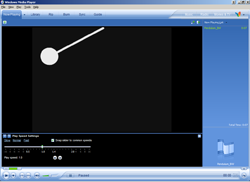NVIDIA's PureVideo Technology
PureVideo Features

Spatial-Temporal De-Interlacing
Explanation - Content that comes over satellite, cable, and from DVD is interlaced data, targeted for TVs, that uses two pictures to provide full picture detail. Since the pictures are taken at different times and then are weaved (interlaced) together, feathering can appear along the moving edges. Many consumer progressive scan TVs and most PCs demonstrate this annoying video problem. PureVideo technology uses the PC industry's most advanced algorithm to remove motion artifacts and maintain full image detail providing a smooth video.
 NVIDIA GeForce 6600 GT |
 ATI Radeon X700 |
In the above example, NVIDIA's spacial-temporal de-interlacing algorithm is used to eliminate the feathering that sometimes appears along the edge of a moving object when playing back interlaced video on the PC. When comparing the same frame from the test video, one captured using a GeForce 6600 GT and the other captured with a Radeon X700, the image produced on the 6600 seems to have the better quality. The jaggies in the arm of the pendulum are less pronounced, and the ball appears well rounded with minimal stair-stepping.
Inverse Telecine (3:2 pulldown)
Explanation - Most high-quality content starts out as film that is shot at 24 frames per second. When it is broadcast as TV programs or saved on DVD it is converted to 30 frames per second to conform to broadcast standards. This conversion process is called telecine (3:2 pull-down). Since the additional frames are simply made up from fields in the original content when converting back to progress frames, this simple conversion can yield images that are blurry. NVIDIA PureVideo technology recovers the original film content to show a clear picture frame after frame and provides hardware acceleration on GeForce 6 Series GPUs in a process called inverse telecine (3:2 pulldown correction).
 NVIDIA GeForce 6600 GT |
 ATI Radeon X700 |
This next pair of images clearly demonstrate the difference in image quality between a GeForce 6600 GT with PureVideo Technology and an ATI Radeon X700. Pay special attention to the tracks in the lower-right portion of the frame, and the lines along the roof of the trolley. The NVIDIA powered card cleans up the artifacts that are visible when watching this particular clip on the Radeon.
We would like to mention that for the majority of the clip, these artifacts are barely visible with either card, and it's only in a sampling of frames that there is a clearly noticeable difference between the two cards' output. And after spending a few hours experimenting with a collection of DVDs, we weren't able to find any better examples of these artifacts with any "real world" content.






